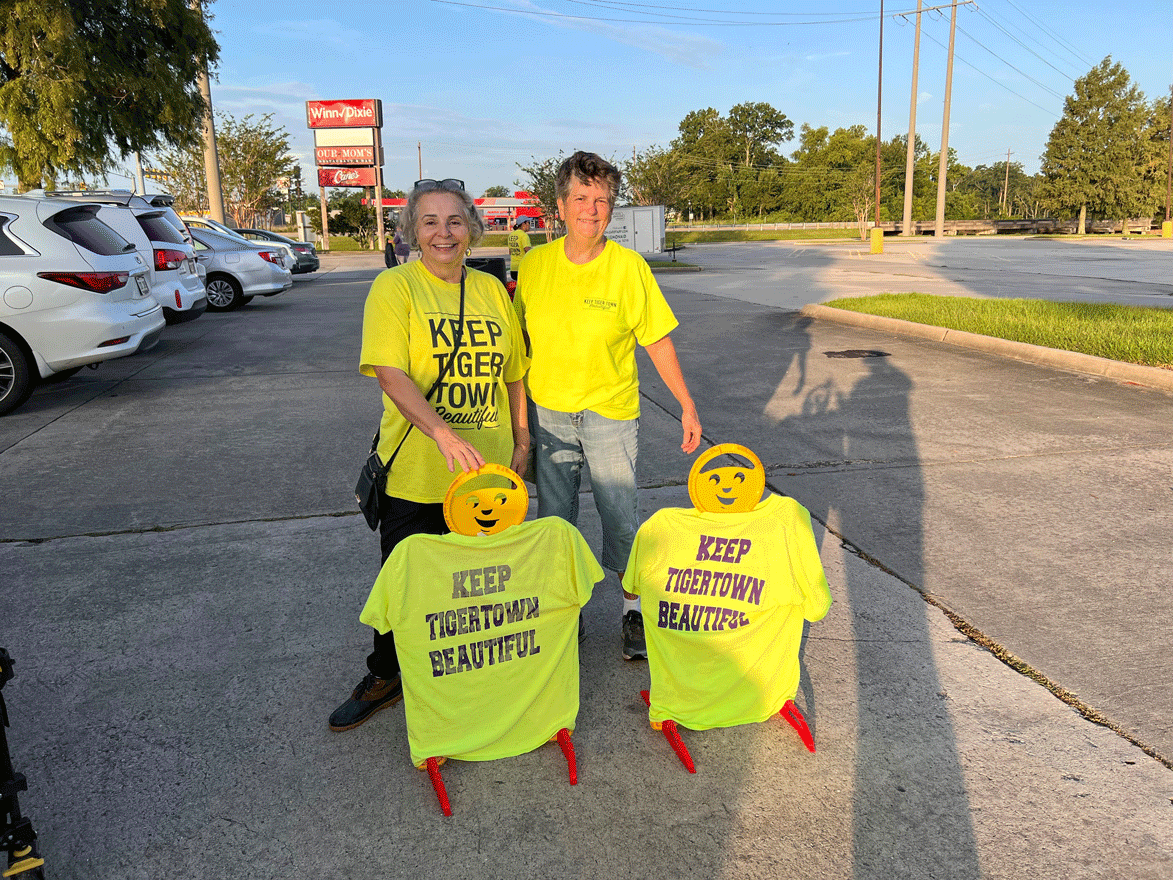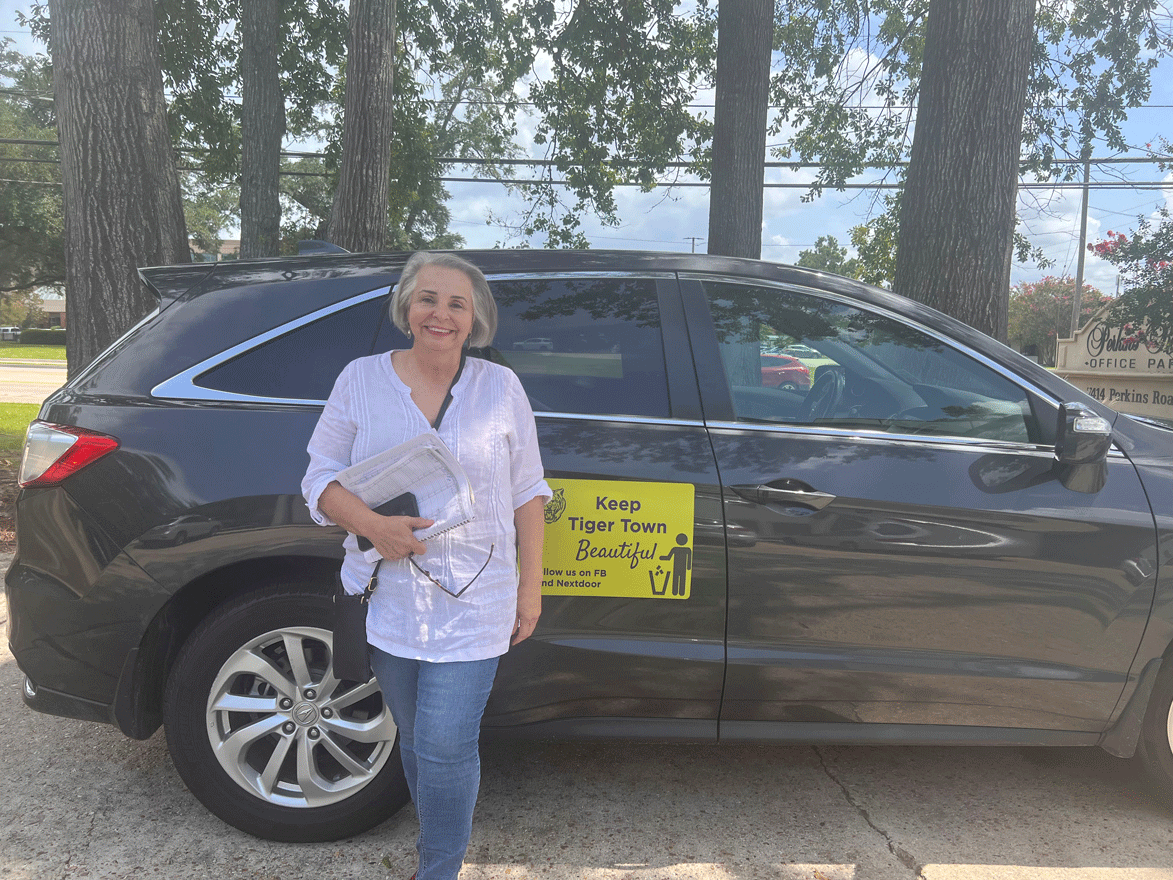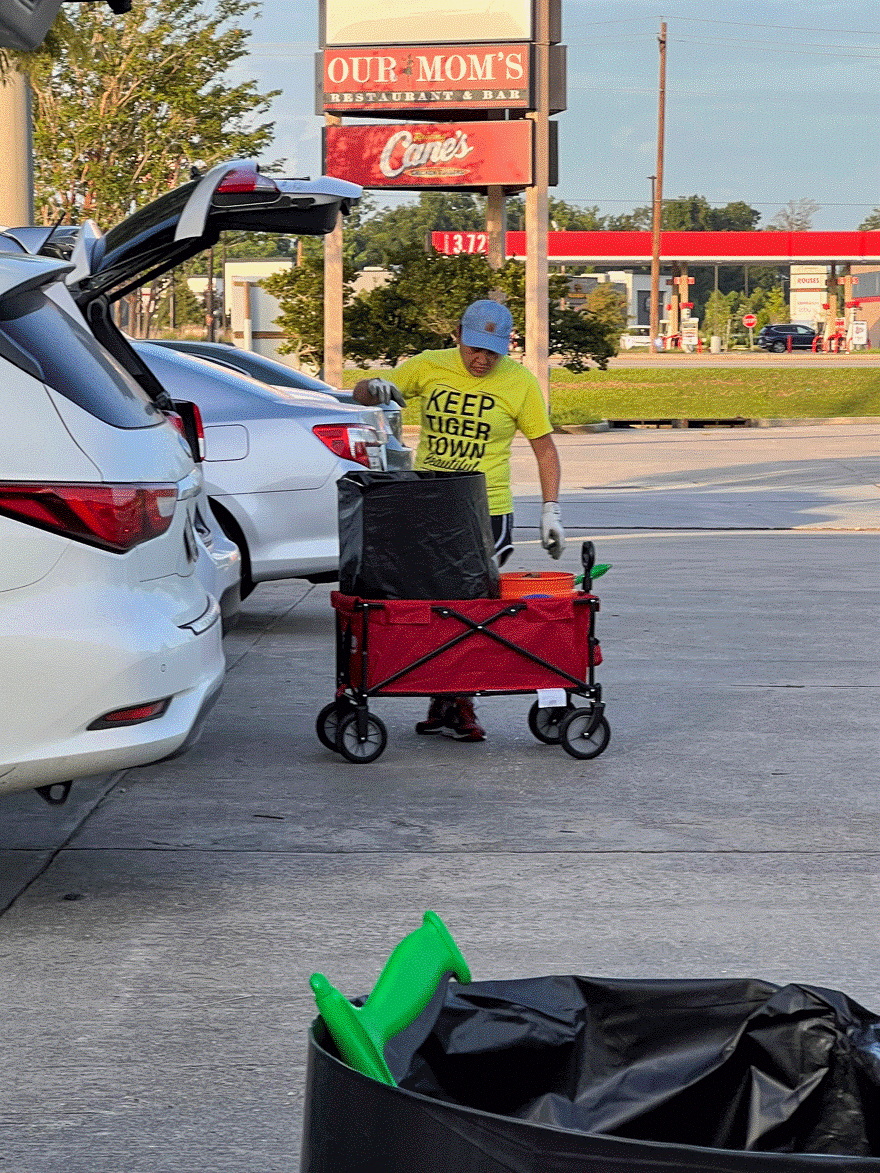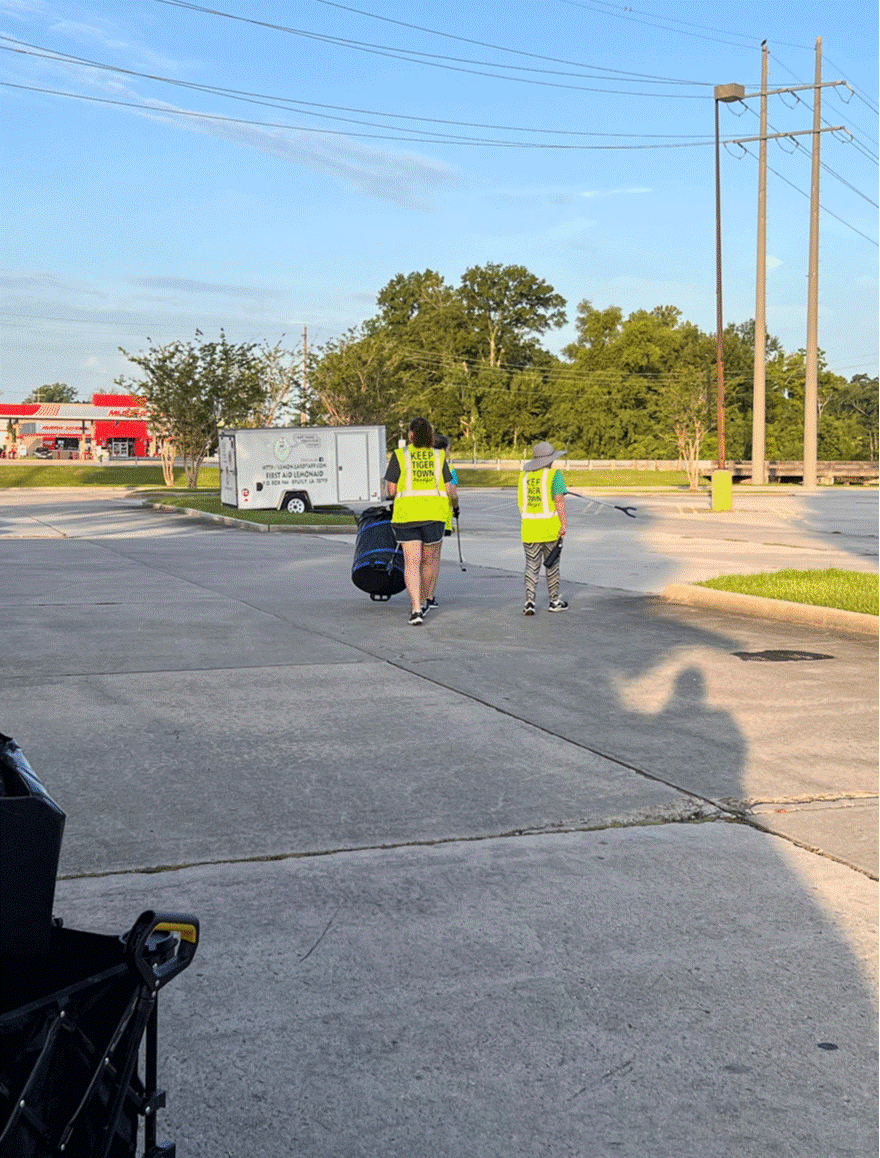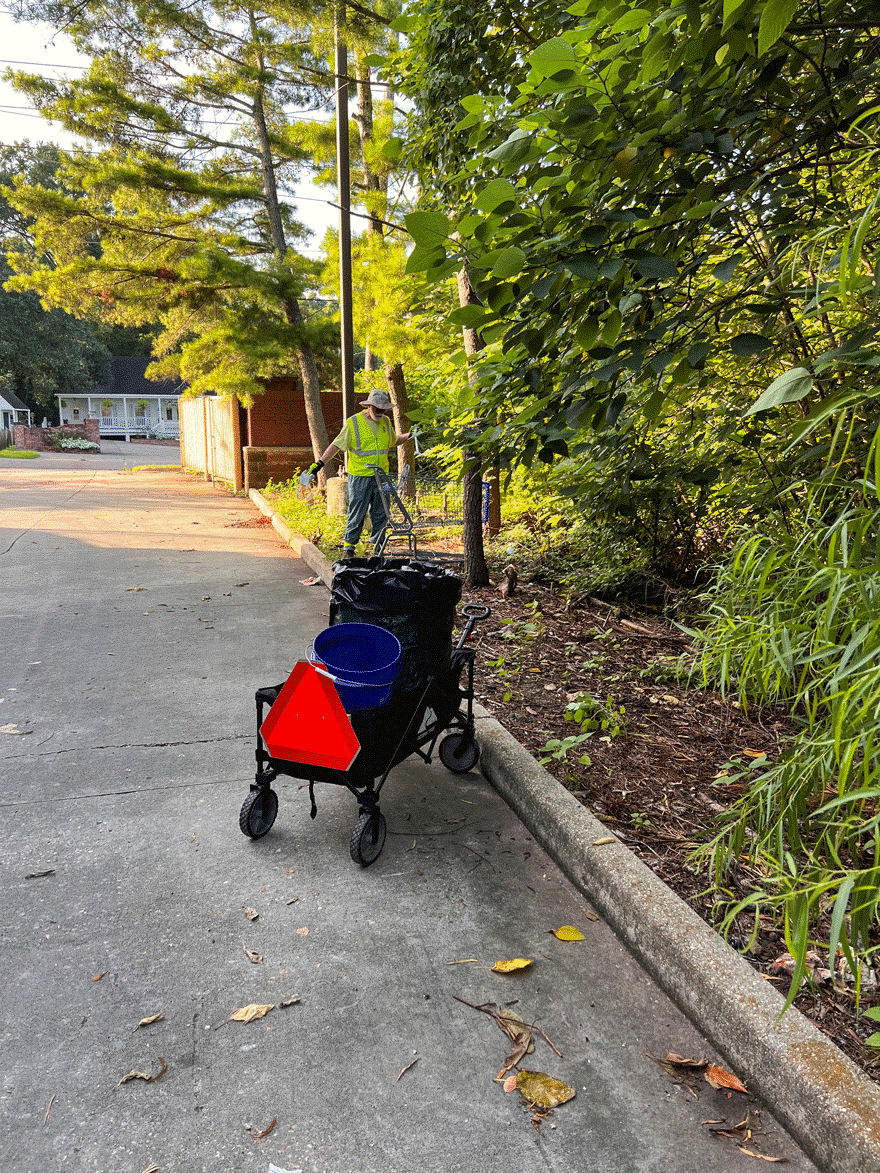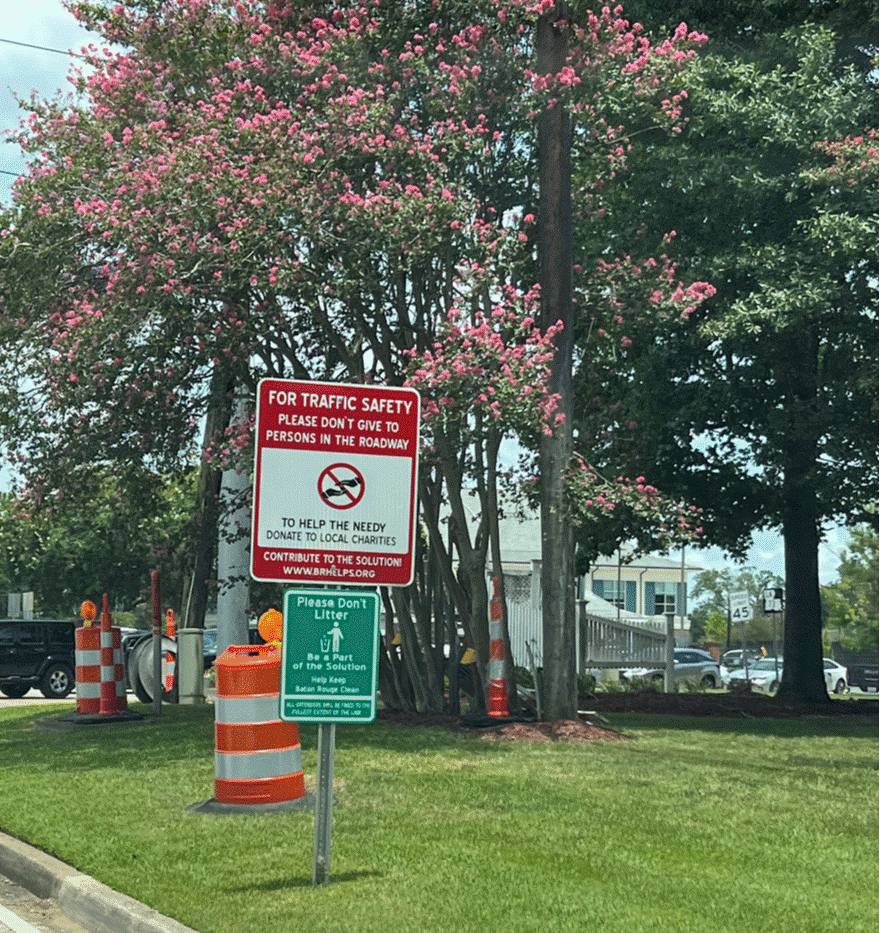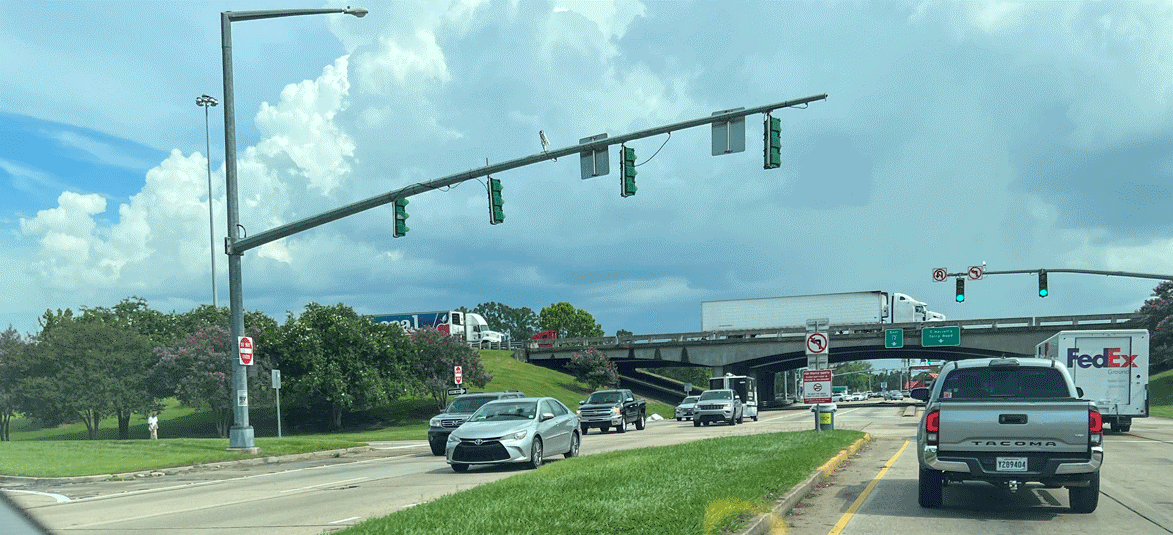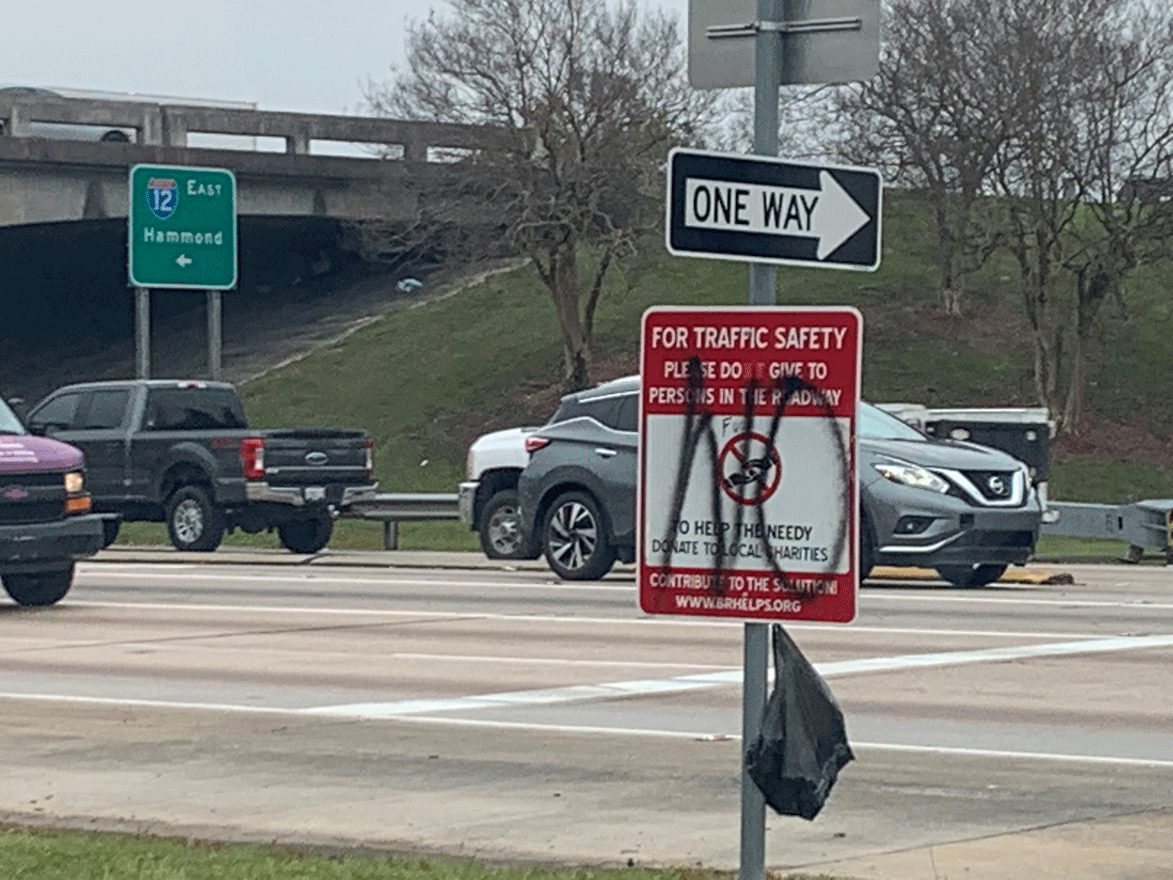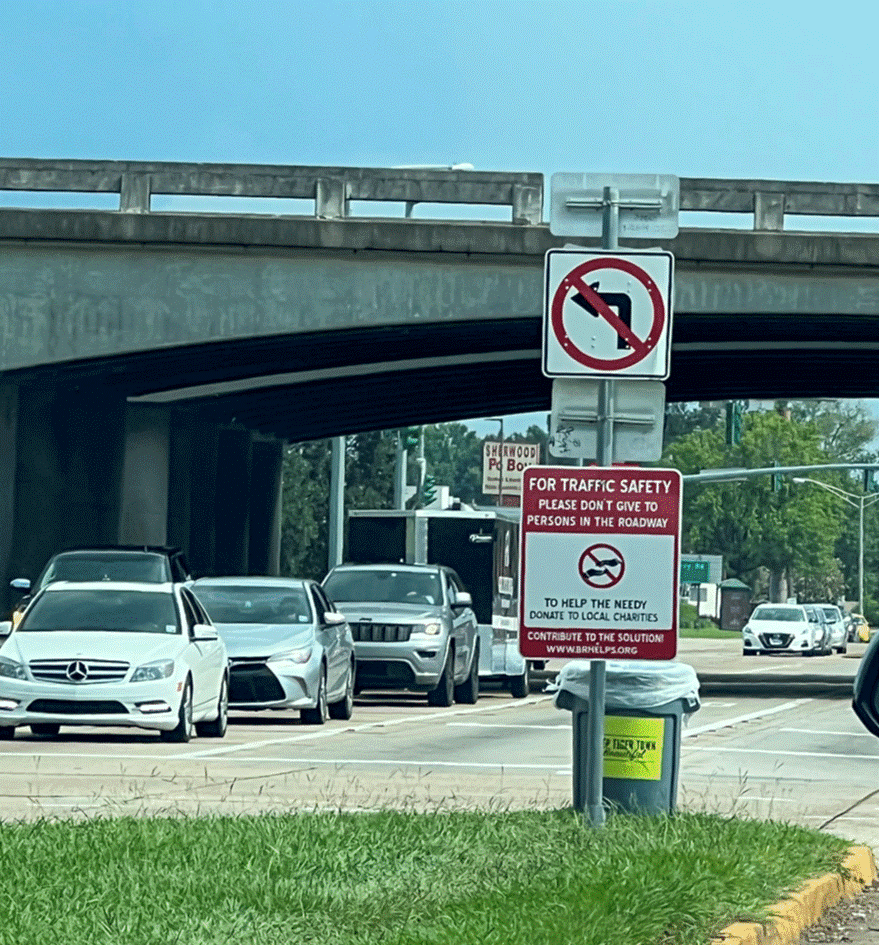Keep Tiger Town Beautiful
“Never doubt that a small group of thoughtful, committed citizens can change the world; indeed, it’s the only thing that ever has.”
– Margaret Mead
On a warm, early Saturday morning in July, I joined a group of 17 volunteers from Keep Tiger Town Beautiful to clean up trash along Lee and Burbank drives.
Jennifer Richardson, a Baton Rouge native, founded Keep Tiger Town Beautiful nearly two years ago in an effort to clean up the city. According to the group’s public Facebook page, it has more than 2,600 members and is “for litter warriors who are passionate about keeping Tiger Town beautiful.” The group meets multiple times per week to clean up litter at different locations across East Baton Rouge Parish, with its biggest group of volunteers meeting on Saturday mornings.
I pulled into the parking lot of the shuttered Winn Dixie and was welcomed by Richardson and other volunteers, dressed in bright, neon yellow T shirts and neon yellow safety vests with the group’s slogan printed on the back. They also wore work gloves, long pants, sun hats and rubber boots. Some were veterans of the group, and a few were newbies like me. Richardson greeted me with the same enthusiasm she had a few days earlier when I interviewed her at her Latter and Blum office on Perkins Road.
In a world of thinkers, feelers and doers, Richardson is the posterchild for a doer. She is petite and energetic with a contagious smile, flawless skin and gray hair that ends right below her ears. She raised three children as a single mom and is now a grandmother to five grandchildren. She works as a realtor, owns and manages rental properties across the city and volunteers with St. Agnes Homeless Shelter, but her passion is litter cleanup.
“It’s taken over my sinus cavities at this point,” she says. “But look, trash begets trash. It builds up like a game of Tetris. If we don’t take care of the bottom row, it just keeps building and building and building and then it explodes.”
There are nearly 50 billion pieces of litter along U.S. roadways and waterways, according to a 2021 study from Keep America Beautiful, a Stamford, Conn.-based nonprofit established in 1953 that provides information, programs, and resources to communities to help end littering, improve recycling, and beautify communities. More than 90 percent of people surveyed by Keep America Beautiful believe that litter is a problem in their states.
Richardson is one of them. She started Keep Tiger Town Beautiful in January 2021 after frustrated by the amount of trash she saw while stopped at a red light at the corner of Essen Lane and Jefferson Highway.
“I was sick of waiting on someone to take care of it,” she says. “So, I went out there and I did it myself. I had my Maw Maw tools and was pulling weeds and picking up trash. When people saw me and asked me what I was doing, they thought I had lost my mind. I told them ‘I’m cleaning up this filthy city.’ I grew up here and I love this city, and I want it to be better.”
The next day she posted information on the social media platforms, Nextdoor and Facebook, asking for people to come help her clean up Baton Rouge. Eight people joined her, and the group continued to steadily grow. In the last year and a half, the group has picked up more than 3,700 bags of trash around South Baton Rouge and continues to attract new volunteers. Nearly every day, Richardson posts what she calls “Popup” cleanings on the group’s Facebook page – where she lists the day, time and location of the next cleanup. There are typically six Popups weekly, with the largest Popup on Saturday mornings. At each Popup, they focus on cleaning a specific area in south Baton Rouge – mainly streets that are high traffic and near businesses and the interstates, like Sherwood Forest, Bluebonnet and Coursey boulevards, Siegen Lane and Government Street.
Richardson started this mission with $200, a few tools and a deep spiritual belief that it was her calling to organize this group. Keep Tiger Town Beautiful is not a registered 501c3 nonprofit and she likes it that way. There is no red tape, no rules, just a collective goal to pick up trash and beautify the city.
“We are rogue,” she says. “We don’t need a study, a survey or to fill out a form. We just need to get out there and clean it up. That’s what we’re doing, and we are kicking ass and taking names.”
She describes the group as having a “Loaves and Fishes” mentality, meaning generosity and miracles have appeared throughout the last 18 months. The group has never been in need of anything. Whatever it has needed, someone has brought. Strangers have dropped off boxes of contractor-grade garbage bags to her home and office, businesses around the city donated blue trash cans, trash grabbers, T shirts, safety vests and gloves. A businessman in the community donated an 18-foot brand new trailer, outfitted with a John Deere riding lawn mower, garbage cans, safety vest, bags, everything needed to clean up the streets. Lamar Advertising donated 27 digital billboards promoting Keep Tiger Town Beautiful. Last week, a woman bought the volunteers donuts from Mary Lee to express her gratitude. On Saturday, a volunteer brought breakfast for all the volunteers. Chances are if you donate to this group, Richardson is going to call you one of her angels or litter warriors, snap a photo of you and post it on Facebook.
“In a time when the media tells us to hate each other, I can tell you that I see the good in people every day,” she says. “It takes one person to light a spark. God has given me this grace to do so and look at how much good we have done. Our volunteers are from every background, every political party, every color, every sexual preference, and we are all out here doing this together. This has been like a ministry for me, to watch these miracles unfold every week. The community has rallied, supported us, and cheered us on.”
****
I arrived at 7 a.m. on Saturday wearing the brightest orange shirt I own, long workout pants, an old pair of sneakers and work gloves. I brought my own trash grabber. My husband and I bought two back in January when our family spent Martin Luther King Jr., Day picking up trash in our neighborhood to teach our kids about the importance of helping our community. They were 9 and 12 at the time and super excited for about an hour to help. But if I’m being honest, that enthusiasm dwindled as we entered the second hour of trash collection and they started getting grumpy about picking up other people’s garbage.
I can’t say I blame them, and as I started my trek up Lee Drive toward Highland Road with my partner Robert Collins, I was excited to help but a little bit nervous about what I was about to pick up. Collins is retired state worker, with a white beard, a dry sense of humor and a lovely amount of wit. He wore long pants fastened with bright yellow Velcro over the cuffs, brown boots, a yellow T shirt under a fluorescent yellow reflective vest, work gloves and a wide-brim bucket hat. He pulled a wagon loaded with a collapsible garbage can, a blue bucket and his grabber. He has been volunteering every Saturday for about a year with Keep Tiger Town Beautiful. We walked and talked and picked up trash, lots of it compacted in layers of wet leaves. I found a large plastic big gulp type cup that had been there so long that a vine had grown through it. I thought about the same questions that kept running through my mind a few days earlier when I interviewed Baton Rouge City Councilwoman Denise Amoroso.
Isn’t littering illegal? What are the fines? Why isn’t the city picking up this trash? Don’t we pay taxes for this service?
Amoroso was appointed to serve as the District 8 Council Member after her husband Councilman, Buddy Amoroso, died while bike riding in 2018. Prior to his death, Buddy spoke out against littering, even posting a video on Facebook challenging East Baton Rouge residents to spend one minute per day to pick up trash. Amoroso’s constituents live in many of the areas that Keep Tiger Town Beautiful cleans, and she is a supporter of the group, often donating her time, supplies and snacks. She is thankful that Richardson continues her late husband’s mission.
“Unknowingly Jennifer picked up the torch and went with it,” Amoroso says. “I love that she is doing all of this, but she never has to be in the center stage. She is all inclusive – she just wants it done.”
It’s a crime to litter in Louisiana. According to the Louisiana State Legislature, the fines range from $500 to $2,500 with eight to 80 hours of community service tacked on, depending on where you litter, what you litter (ex. cigarettes, cigars vs. trash) and how many times you’re convicted. When I asked her why that law wasn’t enforced, Amoroso offered some perspective.
“The police don’t have the time to chase after people who are littering,” Amoroso says. “They have a lot of other crime to worry about.”
She’s right. Crime is bad in Baton Rouge. The homicide rate in East Baton Rouge Parish has increased nearly 89 percent over the last 10 years, according to data from the East Baton Rouge Coroner’s Office. In 2011, there were 90 homicides in East Baton Rouge Parish. Last year, there were 170 homicides.
But if the police don’t have time to fine people for littering, shouldn’t the city parish have money and resources to manage litter around the city?
Curious about how much of Mayor Sharon Weston Broome’s $1 billion budget for 2022 was allocated to litter, I started doing some research. I pulled up the 2022 Annual Operating Budget, a 543-page PDF on the city’s Web site and started combing through it. I also found an article from the Dec. 7, 2021, issue of The Advocate that broke down the budget. According to that article, East Baton Rouge Parish received more than $165 million from the American Rescue Plan Act. President Bident signed the $1.9 trillion American Rescue Plan Act of 2021 on March 11, 2021, to help local governments across the country with revenue losses from the pandemic.
According to The Advocate article, East Baton Rouge Parish received $165.4 million in rescue plan money in two different allocations – half in May 2021 and the other half in May 2022. A big chunk of that money was used for drainage improvements to fight flooding and pollution in the parish. And “the Department of Maintenance received $853,540 to outsource some of its landscaping, tree maintenance, litter and trash pickup; and routine spraying of ditches and drainage canals,” The Advocate article states.
Curious about these numbers and what part the city should be playing in litter pickup, I asked Amoroso why the city doesn’t send Department of Public Works employees out to pick up trash.
“DPW does not have the time or the manpower to send people out there to go and pickup people’s garbage,” she says. “For city workers to do what Jennifer and her team are doing, the city simply does not have the manpower or time. It’s 100 percent constituents stepping up and donating their time and supplies. None of it is government funded.”
But what would happen if Keep Tiger Town Beautiful volunteers stopped picking up trash or had never started at all, I asked Amoroso.
“There would be unbelievable the amount of trash that would accumulate,” Amoroso says. “I can’t imagine what it would be like.”
I posed the same question to Collins while we were picking up trash in the wooded area behind CVS on the corner of Highland Road and Lee Drive. And his answer didn’t surprise me. He’s neither apathetic nor angry with the process. He has worked in a government setting and understands the limitations and accountability. What Keep Tiger Town Beautiful is doing and what the city of Baton Rouge is doing are not mutually exclusive, he explains. And he joined this group because he liked what they were doing, and the outcome is tangible. He can see the impact he makes every Saturday. He is out there as a volunteer, so his goal is not to be angry and frustrated with the process. Most of the people in this group are over the age of 60 and retired. They are less interested in finger pointing and more interested in just getting it done.
****
Debbie Carbo, Ray Juno, Sue Abshire and Richardson call themselves the “6 a.m. Group.” They are the core four who attend nearly all the Popups during the week. Carbo, Juno and Abshire are all retired and found out about Keep Tiger Town Beautiful on Facebook.
They are not only litter warriors but have become close friends. On a warm Thursday afternoon in July, they meet at Sammy’s restaurant for lunch after spending a couple hours earlier that morning cleaning out ditches and drains along Highland Road. Richardson graciously invites me to lunch to interview her friends. Moments after we sit down, an older woman stops by our table, leans over to Richardson and says, “Great job. Keep up the service.”
“Fans,” Juno says playfully. This group receives a lot of gratitude for their service. During a cleanup, motorists often honk and give them a thumbs up, strangers offer to help while stopped in traffic, and occasionally someone will buy them donuts or bring them cold drinks.
For Juno, originally from New Orleans and retired from Shell since 1992, he was looking for a way to combat trash, found Keep Tiger Town Beautiful on Facebook and asked to join.
“It bothers me and pained me to see all of this trash,” he says. “I like being able to make a difference in that.”
Carbo grew up in West Baton Rouge Parish but has lived in East Baton Rouge Parish since high school. She says she joined the group a little over a year ago because she was passionate about clean up but didn’t want to do it by herself.
“I saw it on Facebook, and it really touched me,” she says. “I love the satisfaction of seeing the city clean.” She often will attend a Popup and then stop and pick up even more trash on her way home.
Abshire, retired from Our Lady of the Lake, has lived in Baton Rouge for nearly 40 years and has been with Keep Tiger Town Beautiful since January.
“I had traveled to Georgia and Texas and noticed how clean it was there, and it was embarrassing how much trash we had in Baton Rouge,” Abshire says. “I wanted to do something, and I saw the Facebook group. It was exactly what I was looking for.”
Not only is this core group incredibly energetic, tenacious and bulldogged, but they are also generous with their storytelling and welcoming to anyone who wants to help. They wish even more people would join the group.
“We have about 2,700 members on our Facebook page but we have 23,000 followers, can you imagine what it would be like if that many people came out each week to pick up trash,” Richardson says. “Imagine the impact.”
This group also doesn’t take life too seriously. They are funny. Like really, really funny and their stories about what they find made me belly laugh during lunch. They have a private Facebook page they call “Trash Talk” where they share all the “unmentionables” – mainly sex toys – they pick up during the cleanups. They have also found money, coins and cash, mainly. One time, they found $201 in an otherwise empty wallet – which they used to buy more contractor garbage bags and another time they found a fake $100 bill.
They have also found a microwave, a couch and lots of car parts. And one time, they even found a stainless-steel kitchen sink on Government Street. When they told this story, it was immediately followed up by a “Everything but the kitchen sink,” joke. They have pulled 16 shopping carts from a ditch along Cedarcrest Avenue and found 31 shopping carts along College Drive. They have also found knives, razors and one time, a loaded pink gun that they turned into the police.
I ask them if picking up trash in the same areas repeatedly is a frustrating boomerang task that feels like it never ends.
“Oh no. We are seeing the impact. There used to be a carpet of litter. We used to pick up 40 bags of trash at an intersection, now it’s only seven or eight,” Richardson says. “There is a method to our madness, and it’s working.”
The day I volunteered at Lee and Burbank drives, 18 bags of trash were collected, compared to the 83 bags of trash they collected the first time they cleaned that area.
They agree that the worst areas to clean are Sherwood Forest Boulevard and Siegen Lane or “the hell hole,” Richardson and Abshire say, because of the discarded used condoms, crack pipes, bongs, small balloons filled with drugs, and hypodermic needles they find. But after they posted pictures of all the needles they collected, a volunteer and friend of the group dropped off red Sharps containers – safe receptacles for the disposal of needles – to Richardson.
Richardson is vocal about the number of drug addicted people she meets during cleanups. She says they are typically the panhandlers asking for money at the off ramps from the Interstate onto major roadways in the city, including Siegen Lane, Sherwood Forest Boulevard and College Drive. The city placed red and white signs at some of the higher volume panhandling areas to discourage donations. The signs read: “For traffic safety, please don’t give to persons in the roadway. To help the needy, donate to local charities. Contribute to the solution! www.brhelps.org.” The Web site links to the Capital Area United Way fundraising campaign for the homeless where you can donate.
Richardson encourages people not to give the panhandlers money because after a year and half of cleaning the same area and talking to the same people, she says they are using the money to buy drugs.
“Litter begets crime. When there’s a filthy area, criminals know that no one cares about that area. Cleaning up the city sets up the future for the city,” Richardson says. “Drug addiction is real. We pick up Narcan containers all the time, needles, spoons, and those teeth flossers that are used to cut drugs. And when you give them money, this is where your money is going. You are basically supporting the drug dealers in our city. Our city is scary right now, and I have to say what I have to say because if I don’t, it’s not going to get better, and people are unaware of what’s going on.”
Narcan is a medication used to for the emergency treatment of opioid overdose. City officials say overdose deaths – especially related to the synthetic opioid drug, Fentanyl – is an epidemic in Baton Rouge. According to the East Baton Rouge Coroner’s Office, there were 311 fatal overdoses in the parish in 2021, an alarming 1,010 percent more than the 28 reported in 2012.
On April 4, EBR Coroner Dr. Beau Clark spoke to a group of parents at a lunch and learn at my kids’ school about the dangers of fentanyl, and when I asked him if there was a link between the increase in crime and homicide rates and the increase in the number of overdose cases that he attributed to Fentanyl, he answered, “Absolutely, yes.”
****
I don’t see any needles during the Saturday morning cleanup. I pick up a lot of straws stuck inside plastic tops, beer bottles, liquor bottles and plastic water and energy drink bottles. Abshire found a kids’ spiderman costume but the most exciting thing I found was a broken cell phone charger. When we finish cleaning the woods behind CVS, Collins and I weave our way across Highland Road to a side street behind a bank. He has his wagon, and I found a Walmart shopping cart we decide to return to the store.
We garner a few curious stares. Maybe because I have placed my garbage bag inside the shopping cart or maybe because we are wearing a bright yellow vest and they wonder if we are doing some sort of community service. But we also get a few honks of appreciation and one “Thank you” from a CVS employee picking up trash in the parking lot.
We clean up three different bus stops. Only one has a garbage can near it, and that site is the cleanest of the three. I think about the families who have to sit on benches in the hot sun to wait for a bus. As I pick up water bottles and sticky wrappers covered in ants, I think about their children who are naturally curious and may pick up some of this trash while waiting at these bus stops. Richardson believes trash cans are part of the solution. She has worked hard to put the word out. Fishes and Loaves, as she says. Her call was answered and now there are 15 receptacles placed around the city. She and her volunteers are responsible for emptying the bags while the city’s Department of Public Works picks up those bags along with any garbage collected during each of the group’s Popups.
Collins and I find another rogue Walmart shopping cart and juggle the carts and wagon to make a mad dash across Lee Drive to return them to the store before picking up trash in the parking lot and in the grassy area behind the store. We find lots of wet, compacted trash in the grassy back corner and some that’s blocking drains. It’s nearly 9 a.m. and the sun and humidity are both out in force, but the time has flown by. My face is dripping sweat and my shirt is drenched. My ankles burn from stepping in an ant pile at the start of the cleanup, and while I feel like we are making a difference, I know there is so much more to pick up. At the same time, I feel purposeful and connected. I enjoyed Collins’ company and we spent our time alternating between talking and picking up litter in silence.
When we get back to the parking lot, we drop off our bags on the curb with the other bags collected, and I thank Collins and Richardson for letting me interview them and spend the day learning about Keep Tiger Town Beautiful. I will be back even though it was hot and stinky at times and even a little bit overwhelming. I change into some clean shoes, place my work gloves and dirty sneakers into the back of my car and head home to my family.
As I drive by one of the bus stops on Lee Drive near the corner of Highland Road, I am so grateful that I took the time to clean the ground around the bench because it’s there that I see a woman with four small children sitting and waiting for the bus. I smile, feeling my chest tighten and tears welling up in my eyes. This is the feeling that keeps people coming back – being connected to other humans and knowing one small act of service creates a ripple effect.
July 25, 2022
